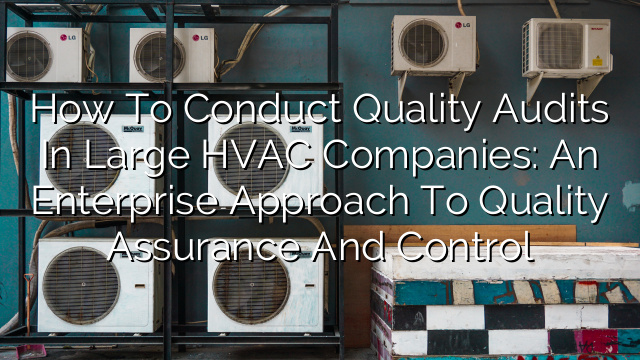Introduction
Quality assurance and control are essential factors in ensuring the smooth operation and reliability of HVAC systems. For large HVAC companies that handle numerous projects, conducting quality audits becomes even more critical. In this blog post, we will explore an enterprise approach to quality assurance and control for large HVAC companies, providing valuable insights and practical tips on how to conduct quality audits effectively.
The Importance of Quality Audits
Quality audits play a crucial role in ensuring that HVAC systems meet industry standards, adhere to design specifications, and function optimally. By conducting regular quality audits, large HVAC companies can identify and address any potential issues, reduce the risk of system failures, and enhance customer satisfaction. Quality audits also allow companies to evaluate their internal processes, identify areas for improvement, and ensure compliance with regulatory requirements.
An Enterprise Approach to Quality Assurance and Control
Implementing an enterprise approach to quality assurance and control can streamline the auditing process and enhance its effectiveness. Here are some key steps to consider:
- Establish Clear Quality Objectives: Define specific quality objectives that align with your company’s mission and values. These objectives should be measurable, realistic, and time-bound. Examples of quality objectives include achieving a certain level of customer satisfaction, minimizing system failures, and meeting project deadlines.
- Develop Comprehensive Quality Auditing Procedures: Create standardized procedures and checklists for conducting quality audits. These procedures should cover all essential aspects of the audit, such as performing visual inspections, testing system performance, and reviewing documentation. Be sure to include clear guidelines on how to handle any identified issues and how to document audit findings.
- Train and Empower Auditors: Provide comprehensive training to your auditors to ensure they understand the audit procedures and can perform their tasks effectively. Ensure that auditors are also trained in relevant industry standards and regulations. Additionally, empower auditors to make decisions and take actions to address any identified issues during the audit process.
- Utilize Technology for Auditing: Leverage technology solutions to simplify and automate the auditing process. Implement software or mobile applications that allow auditors to input data and generate audit reports efficiently. Digital tools can streamline data collection, analysis, and documentation, reducing the chances of errors and improving overall audit efficiency.
- Emphasize Data Analysis and Continuous Improvement: Collect and analyze data from quality audits to identify trends, recurring issues, and opportunities for improvement. Regularly review and update your quality auditing procedures based on these insights. By promoting a culture of continuous improvement, you can enhance the effectiveness of your quality assurance and control processes.
Best Practices for Conducting Quality Audits
In addition to the enterprise approach outlined above, keep these best practices in mind to conduct quality audits effectively:
- Plan Ahead: Clearly define the scope and objectives of each audit in advance. Determine the appropriate frequency of audits for different projects or systems based on their criticality and complexity.
- Ensure Adequate Resources: Provide auditors with the necessary resources (such as tools, equipment, and training) to perform their tasks effectively. Also, allocate sufficient time for audits to ensure thorough inspections and evaluations.
- Collaborate with Key Stakeholders: Involve relevant stakeholders, such as project managers, engineers, and customers, in the auditing process. Seek their input and feedback to gain a comprehensive understanding of the system’s performance and any potential issues.
- Document Everything: Maintain detailed records of all audit activities, findings, and corrective actions taken. This documentation serves as a valuable reference for future audits, allows for traceability, and ensures accountability.
- Follow Up on Corrective Actions: Once issues are identified during an audit, establish a clear process for addressing and resolving them. Regularly follow up on corrective actions to ensure they are implemented effectively and verify their success.
FAQs
1. How often should quality audits be conducted in large HVAC companies?
The frequency of quality audits can vary depending on the size and complexity of projects, industry regulations, and company policies. However, it is generally recommended to conduct quality audits at least annually or whenever significant changes occur in the project or system.
2. What are some common issues identified during quality audits in HVAC systems?
Common issues identified during quality audits in HVAC systems include improper installation, inadequate maintenance practices, system inefficiencies, design deviations, and non-compliance with regulatory standards. These issues can lead to reduced system performance, higher energy consumption, and increased risk of failures.
3. How can companies ensure the effective implementation of corrective actions?
To ensure the effective implementation of corrective actions, companies should establish clear processes for documenting and tracking corrective actions. Assign responsible individuals or teams to oversee the implementation process, and regularly monitor progress. Conduct follow-up audits to verify the success of implemented corrective actions.
4. How can digital tools and technology aid the quality auditing process?
Digital tools and technology can greatly enhance the quality auditing process by streamlining data collection, automating data analysis, and facilitating efficient report generation. These tools can increase accuracy, reduce the chances of errors, and improve overall audit efficiency.
5. What are the benefits of a comprehensive quality assurance and control program?
A comprehensive quality assurance and control program ensures that HVAC systems meet industry standards, adhere to design specifications, and function optimally. This leads to improved customer satisfaction, reduced risk of system failures, enhanced regulatory compliance, and continuous improvement in internal processes. It also helps to maintain a positive brand reputation and increase business competitiveness.
Conclusion
Conducting quality audits in large HVAC companies is essential for ensuring the reliability and performance of HVAC systems. By adopting an enterprise approach to quality assurance and control, implementing best practices, and leveraging technology, companies can streamline the auditing process, identify and address potential issues, and continuously improve their operations. By prioritizing quality, large HVAC companies can deliver exceptional service and maintain a competitive edge in the industry.







